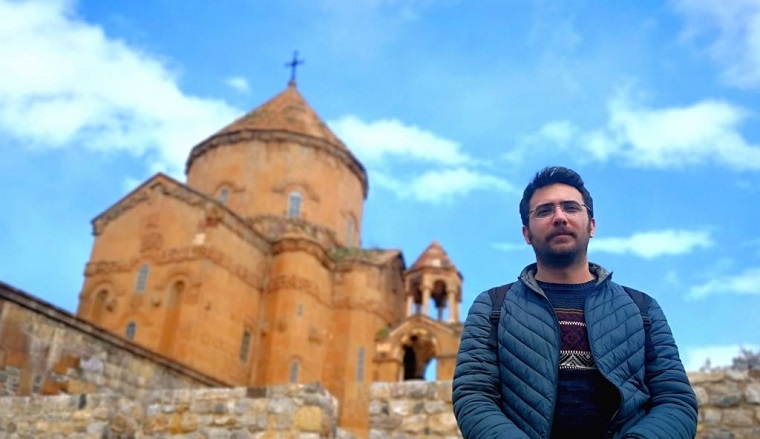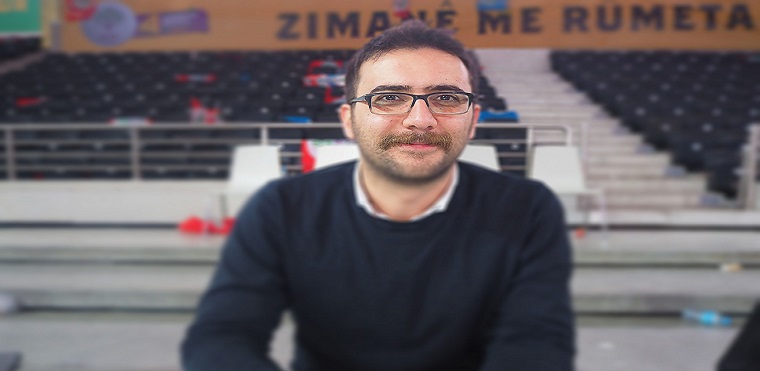Work on documentary on Syriacs and the Genocide of 1915 by Altan Sancar takes off
Interview By Marta Sömek
@gazetesabro – After producing the documentary Sakli Haç, journalist and documentary-maker Altan Sancar is currently carrying out a project which will shed light on the history of the Syriacs and the genocide they suffered during the Sayfo Massacres in 1915. Gateze Sabro’s Marta Sömek interviewed Altan Sancar about his new documentary. They discuss Syriac culture and Syriac presence in Turkey under policies of suppression, the struggle in search for Syriac identity and a lost homeland, their Sayfo trauma and the struggle to hold on to the future in the diaspora.
Tell us about your current project on the Syriacs and the Sayfo Genocide of 1915. What can viewers expect?
Actually, this is not the first documentary I did. It is a sequel to the documentary we shot on Islamized Armenians (ed. Sakli Haç, Turkish for “Hidden Cross”). The main goal of our director Serhat Temel, whom we also worked with on the previous documentary, and producer Şiyar Dicle and our team is to explain and highlight the identity issue in Turkey. The main issue in this country started with identity pressure and denial of identities, with destruction and assimilation of identities. Policies of denial and assimilation are the problem in Turkey. And not only in Turkey for that matter. The same policy is practiced elsewhere in the Middle East, especially in Mesopotamia. It was therefore important to first relate the story on the Armenians who were forced to convert to Islam after surviving the genocide.
I am a Muslim Armenian. On the centennial anniversary of the Armenian Genocide my housemate Yeşuğ Bektaş told me: “Yes, it is the 100th anniversary of the Armenian Genocide, but nobody remembers Sayfo” (Ed. Sayfo is Syriac for “Sword” and is used by Syriacs to refer to the Year of the Sword in 1915). Hearing this fact hurt me a lot. Had we paid the due attention and made noise at the time, maybe there would not have been a genocide against Armenians. Yes, we know about the genocide against Armenians, but we do not know how the policy of genocide on the Syriacs evolved. Even more important is the fact that we hardly know why and how the Syriacs of the southeastern region of Turkey and other countries in the Middle East migrated to the West. The cruel fact is that the Syriacs who live in the diaspora now outnumber those who live in their ancestral lands. For this reason, it is necessary to explain to those living in these ancestral lands that the Syriacs are not just a wine-making or tiny religious community as they think they are, but an ancient and indigenous people of these lands.
Viewers of the documentary will see the history of the Syriac people, find answers to their questions on who the Syriacs are and most importantly understand how Syriac history and culture have left a mark on their very lives and current lifestyle. Most importantly, the viewer will learn what really happened in the Sayfo massacre and what kind of policy was implemented towards the Syriacs. Physical genocides may end but cultural genocides do not. The policies executed towards the assets and properties of the Syriacs and their institutions disclose the fact that the physical genocide may be over, but not the cultural genocide. Such a wound cannot heal or be forgotten. Rather, it continues to revive the bitter past with all its tragic events.
Yes, the Syriacs today have been brought to the level of almost complete extinction. They have been forced to live away from their homelands. They have even been brought to the level where they are told: “We killed you, we destroyed you, there is only handful of you left, but if that handful is left with some property or assets then forget about it because we will not give them back to you”. This is the essential point. This is what it’s about when the audience watches the screen. They will learn who the Syriacs are and what has befallen them, and they can expect to see more atrocious actions to happen to them. Because we also want to explain what should be done for the scabbing of the wound. The scab can bind, but to bind the scab, a confrontation is required as a first step. Some say an apology is needed. Indeed, an apology is important, but it should also be accompanied by action and the will to accept and confront the outcomes.
Ahmet Türk apologized for the Armenian Genocide. That is a very important step. An apology without direct consequences, but still very important for the Christian peoples who actually suffered the genocide in Turkey…
Of course, this apology is normally not to be underestimated. It is necessary to accept reality. We know very well what role the Kurds played in the Armenian Genocide, so it is very important for Ahmet Türk to apologize as a Kurdish politician. But this is not the only place of the wound that still hurts; today there are other people living in and on the houses and lands of the Syriacs and Armenians even though they do not belong to them. They actually belong to the Syriacs. We know very well what will happen when Syriacs or Armenians go back and claim their rights. We have seen what happened to Yazidis who wanted to reclaim their land in Batman, how they were lynched.
This is the main issue. At a screening of our Hidden Cross documentary in Ankara, a Syriac friend came up with a very good question: “Is an apology sufficient… or how can this problem be solved?” The answer whether “this problem can be solved in one day” is actually very difficult for me because the main issue is the question of the assets. Others now live on those lands. They have started a life on those lands while they know it was built on a big lie, founded on huge oppression and on the bloodshed of other peoples. Because of this, an apology alone is simply not enough. It should be an apology that is followed by actions to redress the situation.
So, in fact, it is a double murder….
Absolutely, it is double murder. And for this reason, we say that an apology alone will not be sufficient. The apology must have legal consequences in practice and real life. This documentary we prepared about the Syriacs will also focus on this. Yes, it is about the Syriacs here in Turkey and how they are still trying to hold on to the little bit of life in this country. But we need to have a complete understanding of the situation. A complete understanding of what lies beneath these lands will enable us today to live a more honest and real life in this country and will enable us to build again.

What reasons made you address the Syriac question and do this project?
In fact, the first thing that triggered me were the words of my friend Yeşuğ Bektaş, “Syriacs were also killed in this country but few people know this”.
Was this a confrontation for you?
Yes, it was literally a confrontation for me. I knew Syriacs were targeted. But it was only then that I really understood it was a massacre. As a Muslimized Armenian, I thought that only a massacre against the Armenians was perpetrated in this country, but I found out that a great massacre was also carried out against the Syriacs much earlier. And it should be accepted that the Syriacs are one of the most ancient peoples of this country. Other peoples may claim to have lived here for thousands of years having migrated from other lands, but Syriacs are one of the most ancient indigenous people in this country. That is also a reason why I want to show the atrocious acts of genocide of this ancient people suffered.
Can you describe the picture you are trying to reflect with this documentary?
It will be a classic answer, but I think one can start like this when giving the answer. In an exhibition which the painter Picasso attended, a German general approached Picasso and asked him: “Did you make this painting?”. Picasso answered: “No, you did”.
Our situation is actually like this. The Unionist mentality embarked on a process of nationalization and in this process, it put the “non-Muslims” as its principal target. The goal was to create a 100% Turkish and Muslim country. For this reason, Syriacs, Armenians, Greeks and many others became targets. In the documentary we search for answers to questions such as what happened to the Syriacs during this process, how could hundreds of thousands of Syriacs be killed and why did they become targets. However, our search will not end there. We want to understand how they became ‘minorities’ in their own homeland. Those who will watch the documentary will find an answer as to who the Syriacs are, but they will also see the struggle of the Syriacs living far away from their homeland and their struggle to hold on with stubbornness and faith. Those who will watch the documentary will find answers to what lies beneath the lands on which they live. Everyone should be ready to be confronted.
What perspective is there in the documentary about the 1915 Sayfo Genocide?
Our perspective, building on the previous answer, is to clarify in a structured way why it was possible to destroy a people like the Syriacs within the framework of a nation-building project. We will not tell a story but submit historical facts and present them to the public. We cannot understand this country without knowing the Syriacs. We cannot understand the nature of the conflicts and the situation we are experiencing today without knowing about the Syriacs. This goes for all massacres in 1915 and beyond. Our main goal is to understand and explain.
Where are you in the project?
We started the shooting for the documentary. We had talks with equipment suppliers and also friends who will work with us. We took off so to say. In the process of doing the shooting, some prominent Syriac historians will provide us with guidance and support. We do not want to go wrong when telling the history and suffering of this ancient people. We started with the domestic shootings for the documentary. Shootings in the diaspora will follow. We have a tight agenda because our goal is to make the first screening on June 15. But only if we are able to find a venue for the screenings.
A funding-support campaign was started for your project. What can you tell us about the campaign?
Yes, we started a funding campaign but so far unfortunately we have not had many supporters. This is understandable considering the serious economic crisis in Turkey now, all amidst a very “pleasant” political situation. However, we have decided to start anyway, and we believe that even if the campaign fails in realizing its objective, we will eventually find funding to pay the salaries of the team working on the project. To support the project: https://fongogo.com/Project/suryaniler-mezopotamyanin-kadim-owners
Translated from Turkish @ Gazete Sabro























